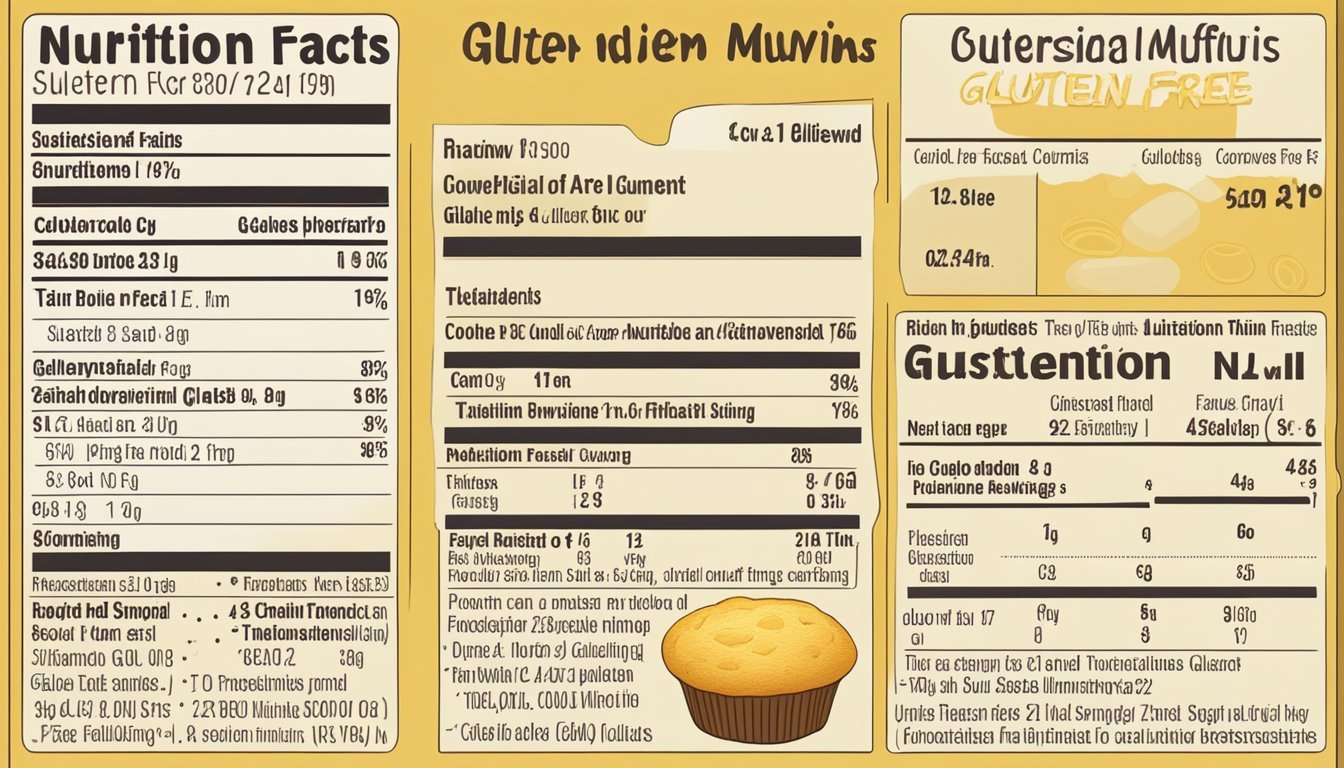Are Cornbread Muffins Gluten-Free?
Unveiling the Truth About Their Ingredients
Cornbread muffins, a classic comfort food, have a distinct texture and sweetness that come from their main ingredient, cornmeal, which is naturally gluten-free. However, traditional cornbread recipes often include wheat flour, which contains gluten, making them unsuitable for individuals with celiac disease or gluten sensitivity. The rise of gluten-free diets has spurred a demand for gluten-free alternatives to many wheat-based foods, including cornbread muffins.
In response to this demand, numerous recipes and premade options now exist to provide gluten-free cornbread muffins without compromising on taste or texture. These versions typically substitute the wheat flour with a blend of gluten-free flours such as oat, rice, or almond flour, and they often include a gluten-free baking powder to ensure the muffins rise properly. It is essential to check all ingredients, including the cornmeal, for a gluten-free certification to avoid cross-contamination with gluten-containing grains.
Those who are choosing gluten-free cornbread muffins, either for health reasons or personal preference, can enjoy a variety of easy-to-make recipes or store-bought products. The key to success is to follow gluten-free guidelines carefully, especially when selecting ingredients, to ensure that the final product is safe for those avoiding gluten. With the right recipe and careful attention to detail, delicious and fluffy gluten-free cornbread muffins are entirely achievable.
Understanding Gluten-Free Diets
Adopting a gluten-free diet involves abstaining from gluten, a group of proteins found in grains like wheat, barley, and rye. This diet is essential for individuals with celiac disease or gluten sensitivity, and using a gluten-free flour blend is crucial in baking items such as cornbread muffins to prevent any gluten intake.
Definition of Gluten-Free
A gluten-free diet excludes all forms of gluten. By FDA standards, foods labeled gluten-free must contain less than 20 parts per million of gluten. This threshold is generally considered safe for people with celiac disease. When crafting gluten-free recipes, alternatives like gluten-free flour blends—combinations of rice flour, potato flour, and other gluten-free flours—are utilized to substitute for traditional wheat flour.
Benefits of Gluten-Free Eating
For individuals with celiac disease, a gluten-free diet is not a choice but a necessity. Consuming gluten can cause severe damage to the small intestine in these individuals. Beyond celiac disease, a gluten-free diet may help alleviate symptoms for people with non-celiac gluten sensitivity. They can experience benefits such as reduced inflammation and improved gastrointestinal health. It's important to note that a gluten-free diet is not inherently healthier for the general population and its advantages pertain primarily to those with a diagnosed sensitivity or allergy to gluten.
The Basics of Cornbread and Muffins
When discussing the foundation of cornbread and muffins, the ingredients play a central role in defining their texture, flavor, and whether they are gluten-free.
Traditional Ingredients for Cornbread
Cornbread typically consists of cornmeal as its main ingredient, providing a distinct grainy texture and a slightly sweet yet savory flavor. A classic cornbread recipe would include the following:
Cornmeal: The heart of the traditional cornbread, giving it its signature taste and texture.
Flour Blend: In gluten-containing recipes, wheat flour is used, but a gluten-free cornbread would employ a gluten-free flour blend.
Baking Powder: A leavening agent to help the bread rise.
Salt: To enhance the overall flavor.
Sugar: Often added for a touch of sweetness, though the amount can vary depending on the recipe.
Milk: Contributes to the moisture and binds the batter.
Egg: Acts as a binder and provides structure.
Butter: Adds richness and can be used to grease the baking pan.
Common Ingredients in Muffins
Muffins are known for their fluffy and moist crumb, achieved through a balanced mixture of ingredients. Here are the staple components found in most muffin recipes:
Flour Blend: The structure of muffins comes from the flour used. For gluten-free alternatives, various gluten-free flour blends are available.
Leavening Agents: Baking powder, and occasionally baking soda, are essential for a muffin's rise and airy interior.
Eggs: Provide structure and stability to the muffin batter.
Milk: Adds moisture and helps to combine dry and wet ingredients.
Sugar: Contributes to the sweet taste and golden crust of muffins.
Butter: Infuses the muffins with a rich flavor and tender texture.
Salt: Just a pinch can enhance and balance the overall flavor profile.
Muffins may be sweet or savory, with additional ingredients added to the basic batter to create a variety of flavors and textures.
Gluten-Free Baking Essentials
When preparing gluten-free cornbread muffins, it is crucial to understand the substitutes and modifications needed for traditional recipes to ensure they cater to gluten intolerance while maintaining the desired taste and texture.
Gluten-Free Flour Alternatives
For gluten-free baking, selecting the right flour is pivotal. Regular wheat flour can be replaced with a variety of gluten-free options, each providing a unique flavor and baking quality. A popular choice is Bob’s Red Mill Gluten-Free 1-to-1 Baking Flour, which is designed to substitute wheat flour with no additional adjustments.
Common gluten-free flours include:
Almond flour
Oat flour (certified gluten-free)
To enhance texture and binding in the absence of gluten, xanthan gum is often added. Typically, 1/4 teaspoon per cup of flour is sufficient.
Adapting Recipes for Gluten-Free Needs
Adapting traditional recipes to gluten-free versions requires more than just substituting flour. Baking soda is usually used in combination with apple cider vinegar to help the dough rise, creating an airy crumb in the muffins. Gluten-free recipes may also call for dairy-free milk, such as almond milk, especially for those who have lactose intolerance in addition to gluten sensitivity.
When altering recipes, observation is key. Gluten-free batter tends to be thicker and may need adjustments in baking time or temperature.
Gluten-Free Cornbread Muffin Recipe
Crafting gluten-free cornbread muffins is straightforward, with emphasis on using gluten-free flour blends and avoiding cross-contamination if baking in a shared kitchen. The result is a delicious, honey-infused treat that aligns with gluten-free dietary needs.
Step-by-Step Instructions
Ingredients:
1 cup yellow cornmeal
1 tablespoon baking powder
1/2 teaspoon salt
2 large eggs
1/4 cup vegetable oil or melted butter
1/4 cup honey
Preheat the oven to 375°F (190°C). Prepare a muffin tin by greasing it or lining with paper liners. If using liners, a light spray of cooking spray can prevent sticking.
In a large bowl, mix together the gluten-free all-purpose flour, yellow cornmeal, baking powder, and salt.
In a separate bowl, whisk together the eggs, milk, oil or melted butter, and honey.
Pour the wet ingredients into the dry ingredients. Stir until just combined, careful not to overmix to keep the muffins light and fluffy.
Distribute the batter evenly among the muffin cups, filling each about 2/3 to 3/4 full.
Bake for 20-25 minutes or until the tops are golden and a toothpick inserted into the center comes out clean.
Cook Time: 20-25 minutes
Prep Time: 10 minutes
Total Time: 30-35 minutes
Cornbread Muffin Variations
Cheese and Jalapeño: Add 1 cup of shredded cheddar cheese and 2 finely diced jalapeños to the batter for a spicy kick.
Blueberry: Gently fold 1 cup of fresh or frozen blueberries into the batter before baking for a sweet twist.
Bacon and Chive: Incorporate 1/2 cup of cooked, crumbled bacon and 1/4 cup of chopped fresh chives for a savory option.
Recipe Card
Ingredient Quantity Gluten-free all-purpose flour 1 cup Yellow cornmeal 1 cup Baking powder 1 tablespoon Salt 1/2 teaspoon Large eggs 2 Milk (dairy or non-dairy) 1 cup Vegetable oil or melted butter 1/4 cup Honey 1/4 cup Prep Time 10 minutes Cook Time 20-25 minutes Total Time 30-35 minutes
Remember to use the recipe card as a quick reference for the quantities of each ingredient needed for the gluten-free cornbread muffin recipe.
Nutritional Information for Cornbread Muffins
When assessing the nutritional value of cornbread muffins, it is critical to consider their calorie content and the balance of macronutrients which includes protein, fats, and carbohydrates, as well as fiber.
Calorie Breakdown
Cornbread muffins typically have a calorie range that depends on the ingredients and serving sizes. On average, a medium-sized cornbread muffin may contain about 200 to 300 calories.
Calories: 200-300 per muffin
This caloric content may fluctuate based on the addition of ingredients such as cheese, honey, or whether one chooses a gluten-free recipe.
Macronutrients and Fiber Content
Macronutrients are the primary components that provide energy and include protein, fat, and carbohydrates. Cornbread muffins are predominantly a carbohydrate-rich food due to their cornmeal and flour components. They also contain moderate amounts of fat and minimal protein.
Carbohydrates: Provide the bulk of the calories.
Protein: Relatively low; may be around 3 to 5 grams per muffin.
Fat: Varied depending on recipe; saturated fat content should be observed.
Fiber: Depending on the use of whole grain flours, fiber content can range from 1 to 3 grams per muffin.
In terms of other nutrients, cornbread muffins can contain small amounts of sodium and cholesterol. Gluten-free cornbread muffins might use alternative flours which can impact the overall macronutrient and fiber content.
Cooking and Storing Tips
Ensuring that cornbread muffins maintain their soft and fluffy texture requires proper baking methods and storage techniques. Not only will these tips help maintain freshness, but they'll also preserve the muffins' ideal consistency.
Best Practices for Baking
When baking cornbread muffins, starting with an oven preheated to the recipe’s specified temperature is vital for even cooking. It's advisable to use cooking spray or liners to prevent sticking and achieve a soft crust. For even cooking and a fluffy texture, ingredients should be at room temperature before mixing. Filling muffin cups 3/4 full generally yields a good size and helps avoid spillovers. To ensure doneness without overbaking, one can insert a toothpick into the center of a muffin; it should come out clean when they're ready.
Storing and Reheating Tips
For storing cornbread muffins, allow them to cool completely before placing them in an airtight container to retain moisture. They can be kept at room temperature for up to two days. To reheat, it's best to warm them in an oven at a low temperature or microwave in short intervals to keep them from drying out. Wrapping them in a damp paper towel while microwaving helps to maintain a moist texture.
Freezing and Preservation
To freeze cornbread muffins, wrap each one individually in plastic wrap or aluminum foil, and then place them in a freezer bag or an airtight container. They can be frozen for up to three months. Thaw frozen muffins at room temperature or gently reheat them in the oven or microwave. Maintaining the muffins' texture after freezing requires a delicate balance between thawing and reheating without exposing them to too much heat that could dry them out.
Pairing and Serving Suggestions
Gluten-free cornbread muffins are not only delicious on their own, but they also pair wonderfully with a variety of dishes and can be customized with an assortment of garnishes and add-ins to suit any taste.
Complementary Dishes for Cornbread Muffins
Soups and Stews: Cornbread muffins are exemplary for sopping up hearty broths and complementing the richness of soups and stews. They are particularly delightful when served alongside a bowl of chili, adding a subtly sweet counterpart to the spicy dish.
Chili: A classic pairing, gluten-free cornbread muffins act as a sponge to absorb flavors and add a tender crumb to each bite.
Thanksgiving: These muffins are a fitting side dish for Thanksgiving, offering a gluten-free bread option that harmonizes with turkey and cranberry sauce.
Cheese and Bacon Additions: Incorporating cheddar cheese or bacon into the batter elevates the muffins to a savory treat that is perfect for brunch or a snack.
Cheddar: Sharp or mild cheddar cheese can be mixed into the batter for a cheesy twist.
Bacon: Crispy bacon bits add a smoky flavor and a satisfying crunch.
Garnishes and Add-Ins
Sweet Options:
Jam: Spread a fruity jam over warm cornbread muffins for a sweet and tart contrast.
Honey or Maple Syrup: A drizzle of honey or maple syrup is perfect for enhancing the natural sweetness of the cornbread.
Savory Choices:
Herbs: Fresh herbs such as rosemary or thyme can be sprinkled on top before baking for an aromatic kick.
Butter: A pat of butter melting into a hot muffin adds a creamy note, enriching the overall flavor.
Addressing Common Questions
When it comes to gluten-free baking, ensuring the absence of gluten in all ingredients is crucial. Readers frequently ask about the specifics of making cornbread muffins gluten-free, including ingredient modifications and prevention of cross-contamination.
FAQ on Gluten-Free Cornbread Muffins
What makes cornbread muffins gluten-free?
Gluten-free cornbread muffins do not contain any gluten, which is a group of proteins commonly found in wheat, barley, rye, and triticale. To make them gluten-free, one typically uses cornmeal and substitutes wheat flour with gluten-free flour blends.Can cross-contamination occur with gluten-free cornbread muffins?
Yes, cross-contamination can occur if gluten-free cornbread muffins are prepared in a kitchen that also handles gluten-containing foods. Using separate utensils and surfaces is recommended to avoid cross-contamination.Are gluten-free cornbread muffins also dairy-free?
They can be. Many recipes for gluten-free cornbread muffins use milk, but this can be replaced with dairy-free alternatives like almond milk, soy milk, or rice milk. Additionally, vegan butter or oils can be used in place of regular butter to cater to dairy-free requirements.Is it possible to substitute dairy-free and vegan options in gluten-free cornbread muffin recipes without affecting the texture?
Yes, it's possible to use dairy-free and vegan substitutes such as vegan butter or oil and still retain a desirable texture. The key is to measure these alternatives accurately and select ones that complement the flavor profile of the cornbread.
Advanced Gluten-Free Baking Techniques
When crafting gluten-free cornbread muffins, the baker must navigate multiple challenges to achieve the desired consistency and taste. Specific techniques can enhance the textural quality and infuse rich flavors into these delectable treats.
Enhancing Texture and Flavor
For an exquisite texture in gluten-free cornbread muffins, corn flour is a fundamental ingredient known for its ability to simulate the familiar grainy texture of traditional cornbread. Advanced methods like buttermilk incorporation, which can be a combination of dairy-free milk with an acid like lemon juice, introduce tenderness to the crumb. Homemade cornbread aficionados often employ a cast iron skillet for baking, as it imparts a characteristic crust that is sought-after in both sweet and savory variations.
Exploring flavor enhancements involves melding ingredients such as sharp cheddar, jalapeño, and even fruits like blueberry or cranberry for a balance of spicy and sweet profiles. An incorporation of maple syrup in sweet cornbread recipes delivers a rich, complex taste without overpowering the inherent corn flavor.
Expert Tips for Perfect Muffins
Baking Technique:
Preheat the cast iron skillet for a uniformly heated surface.
Employ an ice cream scoop to ensure consistent muffin sizes.
Ingredient Tips:
Use buttermilk or a dairy-free alternative to add depth of flavor.
Opt for a mix of sweeteners, like a touch of honey or sugar alternatives, to suit the desired sweetness level.
Flavor Variations:
For savory options, consider adding finely diced jalapeño or a cup of shredded sharp cheddar.
Sweet variations benefit from fruit additions such as blueberry or cranberry.
Understanding how each component interacts, such as jiffy mix-ins for quick fixes or an old-fashioned approach of from-scratch baking, can determine the success of the final product. Each method demands precision, from measuring ingredients to mixing techniques that avoid overworking the batter.
Additional Resources
When preparing gluten-free cornbread muffins, one may seek out specialty ingredients and develop an understanding of food labeling to ensure dietary requirements are met.
Where to Find Specialty Ingredients
For those interested in crafting gluten-free cornbread muffins, sourcing high-quality, gluten-free ingredients is crucial. One can find pantry staples such as gluten-free cornmeal and specialty mixes, like Arrowhead Mills Gluten-Free Cornbread Mix, at health food stores or well-stocked supermarkets. In addition, online retailers often carry these products and may offer affiliate links through recipe blogs or dedicated gluten-free websites. Such links are often accompanied by a disclosure policy to inform readers of any commissions earned from purchases.
Some recipes may call for unique additions like green chili to enhance the flavor profile. These can typically be found in the international foods aisle or purchased from specialty online stores.
Understanding Food Labels and Regulations
It is essential for consumers to understand food labels to ensure that products comply with gluten-free standards. In the United States, food labeling regulations require that any product claiming to be gluten-free must contain less than 20 parts per million of gluten.
When exploring options like the popular Jiffy Cornbread Mix, it is necessary to read the label carefully, as not all versions of cornbread mix are gluten-free. Labels should be checked for mentions of wheat, barley, rye, or any gluten-containing ingredients.
Moreover, many products will also include a recipe card with suggested adaptations to make the dish gluten-free. These cards often detail substitute ingredients that maintain the desired texture and taste of the final product. It's beneficial to collect and organize these cards for future reference, as they can become handy guides in the gluten-free cooking journey.








